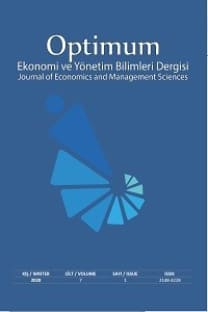Açık İnovasyon Takımlarında Tutumun İnovasyon Üretme Üzerindeki Etkisi
Açık inovasyon, tutum, inovasyon üretme kapasitesi
The Effect of Attitude on Innovation Generation in Open Innovation Teams
Open innovation, attitude, innovation generation capacity,
___
- Ajzen, I. (1991). The Theory of Planned Behavior. Organizational Behavior and Human Decision Processes. 50. 179-211. 10.1016/0749-5978(91)90020-T.
- Ajzen, I., Fishbein, M. (1977). Attitude-behavior relations: A theoretical analysis and review of empirical research. Psychol. Bull. 84:888-918
- Arnold, J., Cooper, C. L., & Robertson, I. T. (1991). Work psychology. Understanding human behaviour in the workplace. Pitman, London
- Büyüköztürk, Ş. (2012). Sosyal bilimler için veri analiz el kitabı. Ankara: Pegem Akedemi Yayıncılık.
- Büyüköztürk, Ş., Kılıç Çakmak, E., Akgün, Ö.E., Karadeniz, Ş. & Demirel, F. (2014). Bilimsel araştırma yöntemleri (17. Baskı). Ankara: Pegem Yayınları
- Chae, B., Li, X. & Zhu, R. (2013). Judging product effectiveness from perceived spatial proximity. Journal of Consumer Research, 40(2), 317-335.
- Chesbrough, H. (2003). Open innovation: the new imperative for creating and profiting from technology. Boston, MA: Harvard Business School Press.
- Chesbrough, H. (2003). The Era of Open Innovation, MIT sloan Management Rewiew, Vol. 44, Issue 3, 35-41.
- Chesbrough, H. W. & Appleyard, M. M. (2007). Open Innovation and Strategy. California Management Review, 50(1), 57–76.
- Coulter, K. S. & Norberg, P. A. (2009). The effects of physical distance between regular and sale prices on numerical difference perceptions. Journal of Consumer Psychology, 19(2), 144-157.
- Davidson, A. R., Jaccard, J. J. (1979). Variables that moderate the attitude-behavior relation: Results of a longitudinal survey. J. Pers. Soc. Psychol. 37: 1 364-76
- Dodgson, M. Gann, D. & Salter, A. (2006).The role of technology in the shift towards open innovation: The case of Procter and Gamble. Research and Development Management, 36, 333–346.
- Festinger, L. (1957). A theory of cognitive dissonance. Stanford University Press.
- Gabrenya, W. K., Arkin, R. M. (1979). The effect of commitment on expectancy value and expectancy weight in social decision making. Pers. Soc. Psychol. Bull. 5:86-90
- Gassmann, O (2006). Opening up the innovation process: Towards an agenda. RandD Management, 36, 223–228.
- Huang, F., Rice, J. (2009). The role of absorptive capacity in facilitating “open innovation” outcomes: a study of australian SMEs in the manufacturing sector. International Journal of Innovation Management Vol. 13, No. 2 pp. 201–220.
- JISC (2009). Facilitating Open Innovation: Landscape and Feasiblity Study, JISC Business and Community Engagement Programme, October.
- Karasar, N. (2004). Bilimsel araştırma yöntemleri [Scientific research methods] (13. Ed.). Ankara: Nobel Publishing.
- King, B. T., Janis, 1. L. (1956). Comparison of the effectiveness of improvised versus non-improvised role-playing in producing opinion changes. Hum. Relat. 9: 1 77-86
- Kline, R.B. (2011). Principles and practice of structural equation modeling. Newyork: The Guilford Press, 3.Baskı.
- Lichtenthaler, U. (2006). Technology exploitation strategies in the context of open innovation. International Journal of Technology Intelligence and Planning, 2(1), 1–21.
- Morris, M., Bessant, J., & Barnes, J. (2006). Using learning networks to enable industrial development: Case studies from South Africa. International Journal of Operations & Production Management.
- Nisbett, R. E., Ross, L. (1980). Human inference: Strategies and shortcomings of social judgment. Englewood Cliffs, NJ: Prentice-Hall.
- Ovacı, C. (2015). Açık İnovasyon ve Tüketicilerin Birlikte Yaratma Davranışlarını Etkileyen Faktörler. Anadolu Üniversitesi Sosyal Bilimler Enstitüsü, Doktora Tezi, Eskişehir.
- Penrose, E.G. (1959). The Theory of the Growth of the Firm. New York:Wiley.
- Powell, R. (1991). Absolute and relative gains in international relations, American Political Science Review, 85(4), 1303–1320.
- Prajogo, D., Ahmed, P. (2006). Relationships between innovation stimulus, innovation capacity, and innovation performance. R&D Management. 36. 10.1111/j.1467 9310.2006.00450.x.
- Seltzer, E., Mahmoudi, D. (2013). Citizen participation, open innovation, and crowdsourcing: Challenges and opportunities for planning. Journal of Planning Literature, 28(1), 3-18.
- Sieg, J. H., Wallin, M. W. & Von Krogh, G. (2010). Managerial challenges in open innovation: a study of innovation intermediation in the chemical industry. Research and Development Management, 40(3), 281-291.
- Schumpeter, J.A. (1942). Capitalism, Socialism and Democracy. Harper. NY.
- Schwartz, S. H. (1978). Temporal instability as a moderator of the attitude-behavior relationship. J. Pers. Soc. Psychol. 36: 715-24
- Stone, J., Cooper, J. (2003). The effect of self-attribute relevance on how selfesteem moderates attitude change in dissonance processes. Journal of Experimental Social Psychology, 39(5), 508-515.
- Taylor, S. E., Fiske, S. T. (1978). Salience, attention, and attribution: Top of the head phenomena. Advances in Experimental Social Psychology, 11, 249-288.
- Thomas, M., Tsai, C. I. (2012). Psychological distance and subjective experience: How distancing reduces the feeling of difficulty. Journal of Consumer Research, 39(2), 324-340.
- Ural, A., Kılıç, İ. (2005). Bilimsel araştırma süreci ve SPSS ile veri analizi. Ankara: Detay Yayıncılık.
- West, J., Gallagher, S. (2006). Challenges of open innovation: The paradox of firm investment in open-source software. Research and Development Management, 36, 319–331.
- Wicker, A. W. (1969). Attitudes versus action: The relationship of verbal and overt behavioral responses to attitude objects. J. Soc. Issues 25:41-78
- Vrande, V. V. D., Jong, J. P. J. D., Vanhaverbeke, W. & Rochemont, M. D. (2009). Open innovation in SMEs: Trends, motives and management challenges. Technovation, Volume 29, Issues 6–7, 423-437.
- Yayın Aralığı: 2
- Başlangıç: 2014
- Yayıncı: -
Küresel Değer Zincirinin Belirleyenleri
Yenilikçi İş Davranışının İş Performansına Etkisi
Muhammed Yusuf GÖKÇEN, Sabahattin ÇETİN
İKY’de Güncel Bir Yaklaşım: Çalışan Deneyimi Kavramının Bibliyometrik Analizi
Modern ve Postmodern Tüketici Davranışları Üzerine Karşılaştırmalı Bir Teorik Tartışma
Hüseyin Çağatay KARABIYIK, Mahmut Nevfel ELGÜN
Liberal Virüs: Sürekli Savaş ve Dünyanın Amerikanlaştırılması
Asya-Avrupa Diyaloğu: Zirve Diplomasisi Bağlamında Bir Değerlendirme
Açık İnovasyon Takımlarında Tutumun İnovasyon Üretme Üzerindeki Etkisi
